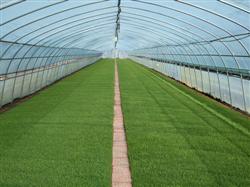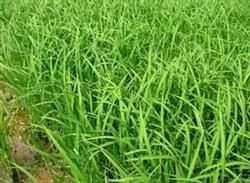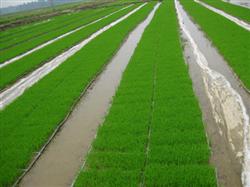Dry Seedling raising technique of Rice Bowl in large and medium greenhouse

(a) Selection. To select high-quality, high-yield, disease resistance and tillering ability in the middle and upper partial ear heavy varieties. Wuchang and Tailai were the representatives of the first accumulated temperature zone, Wuyoudao 1, Songjing 2, Tengxi 140, Wudao 3 and Mudanjiang 19 were suitable as main varieties, Ningan, Fangzheng, Yanshou, Huachuan and Suihua were the representatives of the second accumulated temperature zone, Kendao 8, Tongxi 112, Fujiguang, Hejiang 19, Suijing 4 and Longjing 10 were suitable as main varieties. The third accumulated temperature zone was represented by Mulan and others, which was suitable for Kongyu 131, Suijing 3, Longjing 8 and Shangyu 397. (b) Make a bed. When the soil in the shed melts more than 10 cm, start to turn the ground for seedbed. Before ploughing, fully decomposed farm manure should be evenly applied, the soil should be finely divided without large debris, and the roots and sundries in the soil should be embraced. A footpath is reserved in the middle of the shed, and both sides of the footpath are made into rectangular seedbeds. Seedbed built around 5 cm high ridge (flat ridge). Such as the application of bowl plate seedlings, in the seedbed, pay attention to the effective width of the seedbed and the combination width of the seedling plate, so as not to waste the seedbed. (3) Preparation of nutrient soil. Nutrient soil is prepared by mixing fertile upland soil and decomposed pig manure according to the ratio of 7:3, or by mixing upland soil, decomposed peat and pig manure according to the ratio of 4:4:2, sieving with 6-8 meshes before sowing, and then adding seedling strengthening agent to fully mix and mix for use. 20 kg bed soil per square meter, evenly mixed into the bed soil layer of 3 cm; pot seedling; for example, 561 hole pot tray, about 400 trays per hectare of rice field (due to differences in seedling rate and transplanting density), each seedling tray uses about 2 kg nutrient soil. (iv) Seed treatment. Sunning seeds for 3 days before sowing, selecting seeds with salt water or yellow muddy water with specific gravity of 1.1-1.3, taking out millet, washing, soaking seeds with Spock for disinfection (water temperature of 15-16℃, soaking seeds for 5-7 days); breaking breasts at 30-32℃ after soaking seeds, and reducing the temperature to 25℃ for germination when about 80% of seeds break breasts. when the bud grows to 1-2mm, the temperature is reduced to 15-20 DEG C to air the bud and wait for sowing. (v) Sowing. Before sowing, the bed soil should be poured with bottom water, the bottom of the bowl tray hole should be in close contact with the bed surface, and no gap should be left. Sow 2-3 buds per hole, sow with drawer seeder, or sow manually. Artificial sowing is to put nutrient soil into two-thirds of the holes of the bowl body plate, scrape off excess nutrient soil, water lightly with a fine eye watering pot, wait for the nutrient soil to settle down, spread artificially, sweep the seeds that have not entered the bowl hole into the bowl hole, adjust evenly, cover 0.5 cm of soil, and finally close the weed and cover the plastic film. (6) Management of seedling fields. One is to prevent the temperature in the shed from being too high to breed weak seedlings, and the other is to prevent low temperature and water shortage from breeding small old seedlings. The third is to prevent the rapid change of temperature caused by blight caused by dead seedlings. The seedling age is generally 35-40 days, and the big seedling with 4.5 leaves and one tiller is bred. The suitable temperature required for different growth stages of seedlings is different. The temperature from sowing to emergence is relatively low. The large and medium shed is mainly sealed and insulated. When there is a "top cover" phenomenon, it should be broken up in time, and lightly watered and covered with soil. After the seedlings are fully grown, they are covered with plastic film. The temperature of seedling in one-leaf and one-heart stage is controlled at about 25℃, and the plant height is 4.5-5.5 cm; the temperature in two-leaf and one-heart stage is controlled at 20-25℃, and the plant height is 7.5-8.5 cm; the temperature in three-leaf and one-heart stage is controlled at 20℃, and the seedling height is 12.5-13.5 cm. Water management should be water shortage, especially after 2.5 leaves of water management, due to poor drought resistance of pot seedling, should pay attention to watering. When the dew on the tips of seedlings in the morning decreases or the leaves roll at noon, water them in time in the morning or evening to prevent the seedlings from dying due to high temperature. Water them back and forth slowly, and do not flood them with water. The seedlings began to ventilate at the stage of one leaf and one heart, and the lower control was promoted. Generally, ventilation begins at 9-10 o 'clock on sunny days, and the film is closed at 14-15 o' clock for heat preservation. The ventilation time and ventilation amount should be based on the temperature. When the temperature is low, the ventilation time and ventilation amount should be reduced. Note that the vent should be on the leeward side first, and each time the vent is ventilated, slowly open the vent and gradually increase the ventilation. When the temperature is high in the late stage of seedling raising, ventilation can be carried out from both sides at the same time. Ventilation can be carried out day and night or the film can be removed 3-5 days before transplanting. Disease control should be mainly to prevent bacterial wilt and seedling blight. Spray Zaozhiling, Ekuling or Bingkujing at the 1.5-2.5 leaf stage of seedlings to prevent bacterial wilt and seedling blight, or spray acidified water with pH value of 4 for 1-3 times in combination with watering to prevent bacterial wilt, and wash with clean water after spraying. After seedling 3 leaves stage, if leaves generally turn green and yellow and lack fertilizer, 2-3 kg of potassium dihydrogen phosphate or ammonium sulfate can be used per 100 square meters of seedbed, and 200-300 kg of water can be mixed into 100 times of liquid foliar spray. After spraying fertilizer, clear water should be poured to prevent seedling burning.
- Prev

Dry Seedling raising technique of Rice
According to the investigation in recent years, it is found that most of the rice seedlings are raised in the rice Honda. Honda has poor permeability and cold pulp under perennial flooding conditions, which is not conducive to the cultivation of strong seedlings. Raising seedlings in dry land is to cultivate rice seedlings under the condition of dry land. Oxygen is sufficient in the soil of dry land, and water, gas and fertilizer are easy to coordinate.
- Next

How to apply fertilizer to rice seedlings during the stinging period
"Spring thunder rings, all things grow". Since ancient times, our country has attached great importance to stinging solar terms, and many agricultural activities are about to begin, and the most important agricultural work is "planting seedlings." When the stinging season enters the season of raising rice seedlings, as the saying goes, "half of the rice seedlings are good". In order to obtain high yield of rice, we must first cultivate enough.
Related
- The first cup of black tea in spring, the flavor and history of tea gardens in Kenya, Africa
- The computer can not only choose potatoes, but also grow tea rice. AI will grow winter oolong tea champion.
- It is not only the inflated tea bitten by insects, but also engraved with the four seasons tea in Beipu.
- The Oriental Beauty Tea Festival in Zhuxian County takes the stage at the weekend to experience the plus-size feast of oil tea.
- & quot; Oriental Beauty Tea & Exploration of Emei in Hsinchu, the hometown of quot;
- The new variety of strawberry "Tainong 1" dessert is the first choice with mellow aroma. Crimson gorgeous
- History of Tea in Taiwan: from Wild Inner Mountain to Export Tea Garden
- Two types of Taiwan Oriental Beauty Black Tea won the British three-Star Award for Childhood Tea Xiang Zhang Jiaqi changed from pilot to champion tea maker.
- Banana species and varieties: the planting history of Taiwan Xianren banana and dwarf banana is long, is banana disease resistant?
- Coffee planting Technology: Qianjie Coffee from Seedling to harvesting

